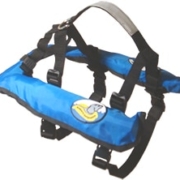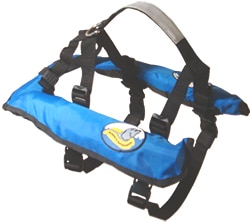Personal Flotation Devices
The terms “life jacket” and “PFD” are interchangeable, with the latter used in the USA and the former used in most of the rest of the world.
You might think this topic is pretty boring and that all we’re going to say is to wear one. Wrong. Actually, this is a pretty interesting topic. Research by a number of marine safety organizations found that many people did not wear PFDs because they were uncomfortable. As a result of the studies, manufacturers were prompted to design more comfortable PFDs and consequently, the number of drownings has significantly declined.
Thus, what we are not going to say then is just “wear one.” Rather, what we are going to say is “Invest in a comfortable PFD and wear it.” The biggest disservice that we do to children is to not have comfortable PFDs for them to wear. And you can imagine parents become so desperate for their child to enjoy boating that when the child starts whining because they are uncomfortable with an ill-fitting type I PFD, the parents take it off thinking, “All is okay—we’ll just pay extra attention.” And that is the death of little Johnny. Please invest in your children’s comfort and think of your purchase of a comfortable PFD as an investment in them enjoying boating—so you can go out more.
Even if you don’t have children, keep multiple, comfortable-fitting child-size PFDs on board. If children are coming out with you, ask the parents to ensure they have a properly sized comfortable PFD, one that the child can wear the entire time while on board.
Let’s take a look at some USA Coast Guard data. This is directly from the USCG site.
Obviously, the best PFD is the one that saves your life every time it’s needed. To accomplish that task, a PFD must be available for proper use at the time of an accident, must be designed to perform well enough to keep your head out of the water, and must be reliable enough to provide its design performance when needed. It is the combination of these three characteristics that defines the life-saving potential, or safety, of your PFD. If a PFD fails to do any one of these three essential tasks, it can’t save your life.
The perfect life preserver, lifejacket, or PFD has not yet been designed. All the designs in existence today have some limitations. For example, Type I PFDs (off-shore lifejackets) have the highest buoyancy of the inherently buoyant Types, but they are not considered comfortable enough to be worn continuously. Therefore, they are frequently not used when accidents occur, and many boaters have died that could have been saved with just part of the buoyancy in this kind of PFD. Another example is the inflatable Type III PFDs. These recently approved PFDs provide the buoyancy of a Type I PFD and are comfortable to wear, but they lack the reliability and low maintenance characteristics, and cost, of inherently buoyant PFDs. Because each style has limitations, users are given a choice of PFDs to match to their particular boating activities. The Coast Guard requires the “Think Safe” pamphlet to be attached to each PFD sold in order to give boaters the information needed to make a good choice.
Accident data clearly shows that Type III PFDs have very significantly reduced fatalities overall, as well as those fatalities in which a PFD was somehow used. While the number of people who boat has steadily increased, the number of drownings (excluding other fatalities) has decreased from about 1500 to 500 annually (from 1971 to 1996) since Type III PFDs were introduced. Equally important, the number of drownings when a PFD was “used” has decreased from nearly 200 to about 55 over the same period. So, while the total number of drownings has been significantly reduced (especially in light of increased boating) the drownings with a PFD used have been even more significantly reduced.
It can’t save you if you don’t use it. Research and boating accident statistics have shown that the most frequent failure resulting in drowning is not having a PFD available when needed. Nearly 1300 (1286) people drowned for lack of a PFD in 1971. Since that time, the Coast Guard has approved Type III PFDs which are more wearable, and in 2006 only 423 people drowned for lack of a PFD. This remarkable reduction occurred even though the number of boats increased from about 5.5 million to over 12 million during the same 35-year period. That means that about 40,000 people are alive today because Type III PFDs are approved. That’s 2400 in 2006 alone when the increase in boating and the trend prior Type III PFDs are considered. The Coast Guard approves a number of Types of PFDs so that you can choose the one that best suits your boating activities and environment. All the types are explained in a pamphlet, entitled “Think Safe”, provided with each PFD sold. This means that people who wear PFDs today are safer than they were 25 years ago.
What about someone drowning while using the “wrong” type PFD? It is unlikely that any different Type of PFD would have prevented most of the drownings where a PFD was used. Consider this regarding PFD performance:
- About 423 people drowned in 2006, apparently because they didn’t have a PFD that they were willing to wear.
- About 51 people died in accidents where PFDs were used, but only in a few of those cases is there any indication that a higher-performing PFD might have prevented the drowning. In the majority of cases, other contributing factors would have overcome the benefits of any PFD. The factors include: being trapped in an overturned boat, being held under a boulder or log by the strong currents of white water, removing the PFD for some reason (like swimming to shore), becoming hypothermic due to the duration of exposure in cold water, suffering other injuries that led to drowning, etc.
- How would you tell someone to safely cross the street? Would you be remiss if you didn’t warn them to look out for objects falling from the sky, like airplane and satellite parts? After all, things can fall out of the sky and kill you; however, the probability is very low. A pedestrian is much more likely to be struck by a car when crossing the street than by falling objects. Likewise, one is much more likely to drown while boating due to not wearing a PFD than wearing one with inadequate performance for conditions that occur only occasionally, and only at places and times that most boaters know to avoid. Additionally, the very best performing PFDs ever made, Type I’s, provide only a small increase in the probability of survival over a Type III PFD.
Inflatable PFDs have a number of limitations as explained in the “Think Safe” pamphlet provided with them, and in some cases, as marked on them. They are not recommended for non-swimmers and are not approved for use on personal watercraft and in water skiing and similar water sports. Additionally, as characterized in the pamphlet, the reliability of inflatable PFDs is less than that of inherently buoyant PFDs. Some say that maintaining them is easy, but that is a small part of the issue. Actually doing the maintenance is the most frequent problem noted in studies to date. So, while inflatable PFDs may increase use in some circumstances, they aren’t suitable for all boating activities, and their reliability when maintained by boaters is yet to be proven.
So wow look at that – the biggest reason that people were not wearing a PFD is that they were uncomfortable and as soon as comfortable PFDs were designed and approved the drownings went down significantly – double significantly.
Regulations and Recommendations
- International (and all local) regulations require that there be at least one PFD for every person on board. They all must be:
- a type I, II, III, or V PFD appropriately sized or a PFD of the proper buoyancy under the new system.
- Properly fitting for each person.
- In serviceable condition.
- Some local government regulations require all persons to wear a PFD under certain circumstances such as: on smaller boats, at times of heightened risk, off the beach sailing yachts, sailboards, kayaks, canoes, and pedal boats.
- Children:
- Local regulations go even further and dictate age requirements for children to wear a PFD at all times. We recommend that right now you do an Internet search for your local government regulations for PFD requirements. In the United States and Australia, these regulations are statewide. In other countries, they are countrywide.
- Your children grow. At the start of each season, or more often, make sure your children fit their PFD and the buoyancy listed is correct. When fitting a child’s PFD, test the fit by lifting the child by the PFD at the shoulders to make sure they don’t slip out.
- Make sure you always buckle the strap that passes between their legs.
- Infants:
- Prior to boating with an infant, test out the fit of the selected PFD in a swimming pool. Since infants grow so fast, you should test the fit of the PFD often.
- The design should be such that the infant naturally rolls and floats face up without assistance.
Pets
-
Not only do people wear personal flotation devices; some are available for dogs and other pets.
While agencies do not certify personal floatation devices for animals, many manufacturers produce life jackets for dogs and cats. Every year dogs and cats die from drowning, either because they do not know how to swim, or because they tire out from overexposure or old age, or have a medical complication such as a seizure, or become unconscious.
-
Most life jackets on the market are designed with foam that wraps around the animal’s torso and neck. They provide a basic amount of buoyancy for a dog, but may not provide enough support for the head. They are not ideal for use with heavy dogs. However, they often incorporate a grab handle, which may help to hoist the dog back into the boat.
-
Although most pet life jackets are passive devices, there is at least one automatically inflated life jacket available for pets (made by Critter’s Inflatable, LLC). An automatic flotation device is generally more expensive than a foam life jacket, but, like automatic PFDs designed for humans, they are less bulky to wear when not inflated, and when inflated may provide more buoyancy than foam devices. Automatic pet flotation devices are popular in the bulldog community, and also for water therapy where extra support may be needed under the head.
-
- Don’t forget to test each PFD at the start of each season. Remember, the law says your PFDs must be in good shape before you use your boat. Ones that are not in good shape should be cut up and thrown away.



 Pets
Pets



